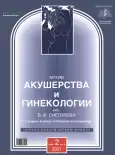Methods for prediction of perinatal outcomes in modern obstetrics
- Authors: Fatkullina I.B.1, Stetsenko N.A.1, Fatkullina Y.N.1, Galeeva S.A.1
-
Affiliations:
- Bashkir State Medical University
- Issue: Vol 8, No 2 (2021)
- Pages: 75-80
- Section: Reviews
- Submitted: 01.06.2021
- Published: 01.06.2021
- URL: https://archivog.com/2313-8726/article/view/71161
- DOI: https://doi.org/10.17816/2313-8726-2021-8-2-75-80
- ID: 71161
Cite item
Abstract
The analysis of works devoted to studies of predicting perinatal outcomes is carried out.
The goal of these studies in obstetric science and practice is to reduce perinatal morbidity and mortality. The strategy of effective assessment of the degree of perinatal risk should be aimed at choosing a rational strategy for managing pregnancy and childbirth, taking into account possible complications for the mother and fetus. Currently, various methods of perinatal diagnosis are used in the world, but the inability to accurately assess the antenatal and intranatal state of the fetus by instrumental methods actualizes the prediction of perinatal outcomes by assessing the degree of perinatal risk.
Full Text
About the authors
Irina B. Fatkullina
Bashkir State Medical University
Author for correspondence.
Email: fib1971@mail.ru
ORCID iD: 0000-0001-5723-2062
Dr. Sci. (Med.), Professor
Russian Federation, UfaNatalia A. Stetsenko
Bashkir State Medical University
Email: natali.polyudova@yandex.ru
ORCID iD: 0000-0003-4247-2295
Russian Federation, Ufa
Yuliya N. Fatkullina
Bashkir State Medical University
Email: fatjul@mail.ru
ORCID iD: 0000-0003-0958-7891
Russian Federation, Ufa
Svetlana A. Galeeva
Bashkir State Medical University
Email: svetagaleeva04@gmail.com
ORCID iD: 0000-0002-6911-3367
Russian Federation, Ufa
References
- Radzinskii VE. Obstetric aggression v.2.0. Moscow: Publishing house of the journal StatusPraesens; 2017. 2nd ed. 872 p. (In Russ).
- Radzinskii VE, Kostin IN, Mamedova MA. The influence of intranatal risk factors on the outcome of labor («intranatal growth»). Vestnik RUDN. Seriya «Meditsina. Akusherstvo i Ginekologiya». 2007;(5):70–72. (In Russ).
- Radzinskii VE, Knyazev SA, Kostin IN. Obstetric risk: maximum information ― minimum danger to mother and baby. Moscow: Eksmo-Press; 2016. 288 p. (In Russ).
- Radzinskii VE, Kostin IN, Zlatovratskaya TV, et al. Full-term children who underwent resuscitation. Analysis of obstetric tactics. Akusherstvo i ginekologiya. 2007;(3):42–47. (In Russ).
- Bezhenar VF, Ivanova LA, Grigoryev SG. High risk pregnancy and perinatal losses. Akusherstvo i ginekologiya. 2020;(3):42–47. (In Russ). doi: 10.18565/aig.2020.3.42-47
- Suverneva AA. Differential approach in predicting unfavorable perinatal outcomes. Mezhdunarodnyi Zhurnal Prikladnykh i Fundamental’nykh Issledovanii. 2013;1(11):69–71. (In Russ).
- Suverneva AA, Mamiev OB, Galkina II. A retrospective analysis of risk factors in women with adverse perinatal outcomes. In: Sukhikh GT, ed. Materials of the XIV All-Russian Scientific Forum “Mother and Child”. [Materialy XIV Vserossiiskogo nauchnogo foruma «Mat’ i ditya»]. Moscow: MEDI Ekspo; 2013. p. 504–505. (In Russ).
- Ivanova LA. Perinatal’nye poteri: novye podkhody k profilaktike na osnove sistemy prognosticheskikh akusherskikh modelei [dissertation]. Saint Petersburg; 2020. Available from: https://www.dissercat.com/content/perinatalnye-poteri-novye-podkhody-k-profilaktike-na-osnove-sistemy-prognosticheskikh-akushe. (In Russ).
- Ivanova LA, et al. Modern Possibilities of Predicting Perinatal Losses: An Educational and Methodological Guide. Saint Petersburg: Voenno-meditsinskaya akademiya imeni S.M. Kirova; 2019. 55 p. (In Russ).
- Semina VI, Stepanova YuA. Examination of arterial cerebral blood flow of the fetus in physiological and complicated pregnancy. Proceedings of the IV Interregional Conference «Baikal’skie vstrechi». Aktual’nye voprosy luchevoi diagnostiki; 2015 Aug 24–25; Irkutsk. Available from: http://baikalconf.ru/images/upload/articles93/197.pdf. (In Russ).
- Patent RUS № RU2674865C1/ 20.07.18. Byul. № 35. Stepanova YuA, Semina VI, Gus AI. Sposob prognozirovaniya neblagopriyatnykh perinatal’nykh iskhodov s pomoshch’yu kompleksnoi otsenki mozgovogo krovoobrashcheniya ploda. Available from: https://yandex.ru/patents/doc/RU2674865C1_20181213 (In Russ).
- Novikova ON, Ushakova GA. Predicting adverse perinatal outcomes in women with intrauterine infection. Fundamental’naya i klinicheskaya meditsina. 2016;1(3):73–80. (In Russ).
- Khvorostukhina NF, Kamalyan SA, Novichkov DA, Naumova E. Umbilical cord entanglement and perinatal outcomes, depending on the method of delivery. Vestnik sovremennoi klinicheskoi meditsiny. 2018;11(6):46–52. (In Russ). doi: 10.20969/VSKM.2018.11(6).46-52
- Kogan YaE. Umbilical cord pathology and its role in perinatal complications. Prakticheskaya meditsina. 2016;1(93):22–25. (In Russ).
- Mochalova MN, Mudrov VA, Kryazheva M. The role of remote cardiophetomonitoring in predicting the outcome of childbirth through the natural birth canal. Materials of the International Conference «Reproductive Medicine: the view of young people ― 2016». Zhurnal akusherstva i zhenskikh boleznei. 2016;65(S1)19–20. (In Russ).
Supplementary files







